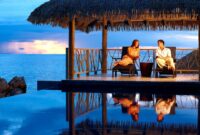Single travel groups over 50 offer a unique blend of independence and camaraderie. These journeys cater to a demographic seeking enriching experiences, fostering connections with like-minded individuals while exploring new horizons. Whether it’s a guided walking tour through a charming European city or a relaxing cruise to exotic locales, the options are diverse and tailored to the specific needs and preferences of mature solo travelers. This exploration delves into the practicalities, benefits, and considerations involved in planning such a trip.
From selecting suitable destinations and tour types to addressing safety concerns and managing budgets, this guide provides a comprehensive overview, empowering individuals to embark on fulfilling solo adventures with confidence and ease. We will examine various aspects, from choosing the right accommodation to prioritizing health and wellness throughout the journey, ensuring a seamless and enriching experience.
Types of Tours and Activities
Choosing the right tour is crucial for a fulfilling single travel experience over 50. Consider your interests, desired pace, and level of independence when selecting a tour type. The following outlines three popular options, highlighting their benefits and drawbacks.
Small Group Walking Tours
Small group walking tours offer a balance of guided exploration and independent time. These tours typically involve a knowledgeable guide leading a group of 8-12 participants through a city’s historical sites and charming neighborhoods. The smaller group size allows for more personalized attention and interaction amongst participants.
Benefits: Intimate group dynamic, personalized attention from the guide, opportunity to connect with fellow travelers, immersive experience of the destination’s culture and history, manageable pace suitable for older adults.
Drawbacks: Less flexibility than independent travel, may not cater to individual interests as extensively as a customized tour, potential for scheduling conflicts if group members have varying preferences.
River Cruise Tours
River cruises provide a relaxing and comfortable way to explore multiple destinations. These tours often include guided excursions in each port of call, onboard lectures, and entertainment. The all-inclusive nature of most river cruises simplifies the travel experience.
Benefits: Relaxed pace, convenient all-inclusive nature, opportunity to see multiple destinations without the hassle of frequent packing and unpacking, onboard amenities and entertainment, generally accessible for those with mobility concerns.
Drawbacks: Limited flexibility in exploring destinations beyond the scheduled excursions, can be more expensive than land-based tours, potential for feeling confined to the ship during some parts of the day.
Cultural Immersion Tours
Cultural immersion tours focus on deeper engagement with a destination’s local culture, often including cooking classes, craft workshops, and interactions with local communities. These tours often have a slower pace than other types and emphasize personal experiences over sightseeing.
Benefits: Unique and enriching experience, deeper understanding of local culture and traditions, opportunity to connect with locals, potential for creating lasting memories, fosters personal growth and cross-cultural understanding.
Drawbacks: May require a higher level of physical activity than some other tour types (depending on the specific activities), might not be suitable for those seeking a fast-paced sightseeing experience, availability may be limited compared to other tour types.
Sample Itinerary: A Week-Long Walking Tour of Rome, Italy
This itinerary focuses on a moderate pace, suitable for travelers over 50, with consideration for accessibility. Adjustments can be made based on individual preferences and physical capabilities.
Day 1: Arrival in Rome, check into hotel near the city center (consider hotels with elevators and accessible rooms). Afternoon: Gentle walking tour of the Piazza Navona and Pantheon, focusing on accessible routes and avoiding excessive uphill climbs. Evening: Dinner at a traditional Trattoria.
Day 2: Vatican City: Pre-booked guided tour of St. Peter’s Basilica and the Vatican Museums, utilizing accessible entrances and elevators where available. Afternoon: Relaxation or optional visit to the Vatican Gardens (check accessibility beforehand).
Day 3: Colosseum and Roman Forum: Guided tour with consideration for pace and accessibility, utilizing accessible entrances and avoiding strenuous climbs. Afternoon: Explore the charming Monti neighborhood.
Day 4: Trevi Fountain and Spanish Steps: Morning visit to the Trevi Fountain (consider the crowds and potential for waiting). Afternoon: Gentle walk to the Spanish Steps, taking breaks as needed. Evening: Enjoy a cooking class focusing on Roman cuisine.
Day 5: Borghese Gallery and Gardens: Pre-booked tour of the Borghese Gallery (accessible routes available). Afternoon: Relaxing stroll through the Borghese Gardens.
Day 6: Appian Way: Optional bike tour or guided walking tour along a section of the Appian Way, choosing a flat and accessible route. Afternoon: Explore the Catacombs (check accessibility beforehand).
Day 7: Departure from Rome.
Accommodation Options
Choosing the right accommodation is crucial for a fulfilling solo travel experience, especially for travelers over 50. Comfort, safety, and convenience are paramount, and the options available cater to a wide range of preferences and budgets. This section will compare three popular accommodation types, highlighting their suitability for mature solo travelers.
Boutique Hotels versus Guesthouses versus Cruise Ships
Boutique hotels, guesthouses, and cruise ships each offer unique advantages and disadvantages for solo travelers over 50. The best choice depends on individual travel style and priorities, such as desired level of social interaction, budget, and preferred travel pace.
- Boutique Hotels: These smaller, independent hotels often offer a more personalized and intimate experience. They frequently feature unique décor and a focus on local character. Amenities might include a concierge service, on-site restaurants, and smaller, more manageable spaces, reducing the feeling of being overwhelmed. A downside can be a lack of the extensive amenities found in larger hotels.
- Guesthouses: Guesthouses provide a more homey and often more affordable alternative. They typically offer fewer amenities than hotels but often compensate with a warm, welcoming atmosphere and opportunities for interaction with the owners and other guests. This can be particularly appealing to solo travelers seeking a sense of community. However, privacy may be less than in a hotel.
- Cruise Ships: Cruises offer an all-inclusive package with accommodation, meals, and entertainment. They provide a structured itinerary and opportunities for social interaction, which can be especially beneficial for solo travelers. However, the cost can be significantly higher than hotels or guesthouses, and the structured nature might not appeal to all travelers. Also, the confined space may not be suitable for those prone to seasickness or who prefer more independent exploration.
Amenities Catering to Older Travelers
Many accommodations now recognize the specific needs of older travelers and provide amenities designed to enhance their comfort and safety. These can significantly improve the overall travel experience.
- Accessibility Features: Features like ramps, elevators, grab bars in bathrooms, and roll-in showers are becoming increasingly common. Many hotels and cruise lines offer rooms specifically designed for accessibility needs.
- Comfortable Bedding and Furnishings: High-quality mattresses, comfortable seating, and well-lit rooms are essential for a restful stay. Many establishments offer options like adjustable beds or firm mattresses.
- On-site Medical Services or Easy Access to Healthcare: Access to a doctor or nurse, or at least a readily available list of nearby medical facilities, can provide peace of mind for older travelers.
- Transportation Assistance: Some hotels offer airport transfers or assistance with local transportation arrangements, reducing the stress of navigating unfamiliar areas.
- Restaurant Options: The availability of varied dining options, including healthy and easily digestible choices, is important. Many accommodations cater to dietary restrictions and preferences.
Visual Representation of a Typical Trip
Imagine a journey meticulously crafted for the discerning solo traveler over 50, a blend of enriching experiences and comfortable companionship. This is not just a tour; it’s an immersion into new cultures and landscapes, fostering connections and creating lasting memories. A typical day unfolds in a rhythm of exploration, relaxation, and engaging social interaction.
A Typical Day on Tour
A Day of Exploration and Relaxation
The day begins with the gentle aroma of freshly brewed coffee and the soft chatter of fellow travelers in the hotel breakfast room. Sunlight streams through the large windows, illuminating a buffet laden with fresh fruit, pastries, and local delicacies. After breakfast, a comfortable, air-conditioned coach whisks the group away to a historical site, perhaps a charming medieval town nestled in rolling hills. The air is crisp and carries the scent of wildflowers. A knowledgeable guide, engaging and personable, leads the tour, sharing captivating stories and historical facts in a clear, easily understandable manner. The cobblestone streets are alive with the sounds of birdsong and the distant chime of church bells. Lunch is a delightful affair at a local trattoria, savoring authentic regional cuisine amidst the lively atmosphere of the town square. The afternoon might involve a leisurely stroll through a picturesque vineyard, the warm sun on your face, the rich scent of grapes hanging heavy in the air, followed by a wine tasting session. The evening concludes with a delicious dinner at a restaurant with a panoramic view, perhaps overlooking a sparkling coastline, the sounds of gentle waves providing a calming backdrop to conversation and laughter.
Evening Social Dynamics
Evenings are a time for relaxation and socializing. The atmosphere is convivial and welcoming, devoid of the pressures of younger travel groups. Conversations flow easily around shared experiences, travel anecdotes, and interests. Some evenings might involve a planned group activity, such as a traditional cooking class or a folklore performance, while others offer the opportunity for quiet relaxation or independent exploration. The common thread is a sense of shared camaraderie and mutual respect, fostering genuine connections among travelers who share a similar life stage and travel style. Laughter echoes through the hotel lounge, a testament to the bonds formed during the day’s adventures. The conversations are relaxed and engaging, ranging from travel stories to personal reflections, all shared in a friendly and supportive environment. Games of cards might break out, or simply quiet chats over a glass of wine, creating a comfortable and welcoming atmosphere. There’s a palpable sense of ease and contentment, a shared understanding of the joys of independent travel in a supportive group setting.
End of Discussion
Embarking on a solo adventure as a traveler over 50 presents a remarkable opportunity for personal growth, discovery, and the forging of new friendships. By carefully considering the factors outlined – from destination selection and tour types to safety precautions and financial planning – individuals can confidently curate a travel experience that is both rewarding and enriching. Remember, the journey is as important as the destination, and embracing the unique opportunities presented by solo travel can lead to unforgettable memories and a deeper understanding of oneself and the world.




